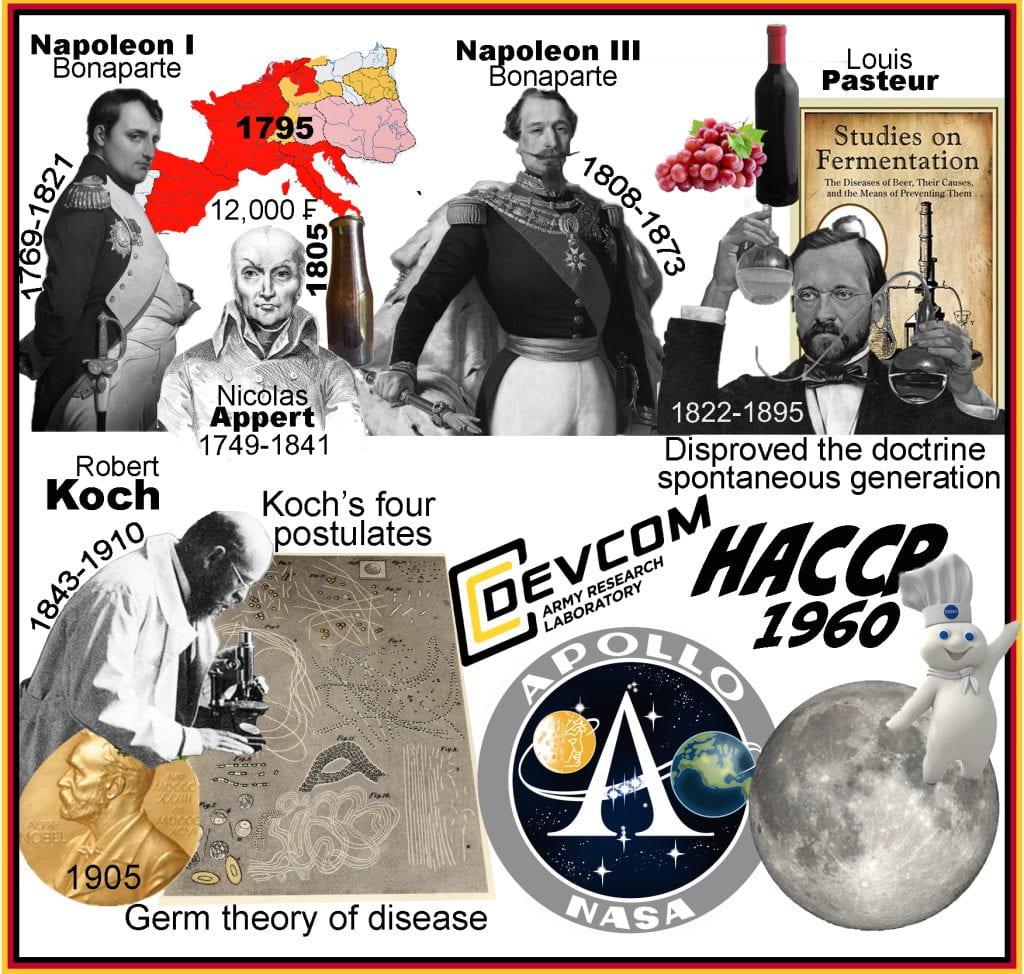A Brief Look at Some Origins of Food Processing
The origins of food science routed in chemistry, microbiology, biology and processing, as well as our modern understanding of nutrition, started at the end of the 1800s and was established through a series of discoveries, often resulting in researchers becoming Nobel laureates. Food Processing is an umbrella term for any modification from field to fork done to an agricultural commodity before consuming it as food, with the intent to increase the self-life, improve safety, alter organoleptic appeal, improve functionality, valorize waste streams, or formulate the smorgasbord of ultra-processed foods that rely on hundreds of varied processes. Before going further, irrespective of the overall impact of food processing, it is essential to consider that the farm’s harvest depends on the time of the season; it is far too much to consume before deleterious reactions spoil the food. Food processing is an essential cog in Canada’s agri-food system and will continue to ensure food waste is minimized.
Before the industrial revolution, during times of colonization, in 1796, Napoleon Bonaparte offered 12,000 Francs (today value ~300,000 Francs) to anyone who could develop a method to preserve food to reach the frontlines allowing troops to advance during seasons when food was unavailable to plunder. Nicolas Appert developed the early canning (Appertization) industry by preserving foods in glass bottles, forming a continuous seal wrapped in cloth and heating in a pressurized vesicle (early retort) to prevent spoilage. At this point, spoilage organisms were unbeknownst to humans and Arostitle’s scientific theory of spontaneous generation that living creatures could arise from nonliving matter and was commonplace. Appertization is still used to imply commercial sterility. The next major advancement in food processing was predicated on the work of Louis Pasteur’s research which are the foundations of hygiene, public health and the germ theory of diseases. During Pasteur’s illustrious career Napoleon III wanted to ensure the quality and limit losses of French wine, which was a major revenue source for the country at that time and sought solutions. His studies on the fermentation of wine sought to prove that similar to alcoholic fermentation, where yeast used to make beer and wine decomposed sugar into ethanol and “carbonic acid” (CO2), there were yeasts able to convert sugar into lactic acid leading to wine spoilage while coining the term microbiology. Pasteur used wine placed in swan-neck flasks and, when heated, prevented the growth of bacteria; however, if the neck of the flask was removed or the flask was tiled to allow the wine to flow through the swan neck, both allowed bacteria to proliferate. These findings became the foundation of pasteurization, disproving the doctrine of spontaneous generation.

Louis Pasteur’s germ theory of diseases showed that diseases could be prevented by killing or stopping germs leading to the invention of pasteurization of milk and wine to stop bacterial contamination. Pasteur’s work established the origins of food processing. Additionally, he is recognized for his role in vaccine development for Rabies, Cholera and Anthrax. Robert Koch, born in 1843, was the father of modern microbiology, establishing the Koch postulate to determine the origins of microbial infections and awarded the Noble Prize in Medicine in 1905 for his studies using his postulate to identify Bacillus anthracis, Mycobacterium tuberculosis, and Vibrio cholera as the causative agent of diseases:
(1) the microorganism must be found in diseased but not healthy individuals;
(2) the microorganism must be cultured from the diseased individual;
(3) inoculation of a healthy individual with the cultured microorganism must recapitulate the disease;
(4) the microorganism must be re-isolated from the inoculated, diseased individual and matched to the original microorganism.
Ensuring Safe Food (HACCP)
Until 1969, if unsafe food entered the Canadian Food supply, it was not until the first cases of illness could be traced back to the food that reactionary measures such as recalling the food could occur. However, this approach to food safety presented a significant challenge to the ambitions of space exploration as a foodborne illness in space would likely be catastrophic. To ensure that Apollo 11 could land on the moon on 06/16/1969, NASA had to devise a model to ensure food sent on the voyage was microorganism-free. NASA worked alongside the US Army Research Laboratories and Pillsbury Foods, developing Hazard Analysis Critical Control Points (HACCP). HACCP is a systematic and preventative system based on seven principles:
1) Conduct a Hazard Analysis (identify all possible food safety hazards (e.g., biological, chemical, or physical),
2) Identify Critical Control Points (CCPs) are control measures essential to prevent or eliminate a hazard to an acceptable level (e.g., monitor the time and temperature of a thermal process).
3) Establish Critical Limits for each CCP that prevent the hazard to an acceptable level (e.g., pH, temp, time).
4) Monitor Critical Control Points involve checking the pH and temperature to ensure they have been achieved.
5) Establish Corrective Actions when monitoring CCP and the critical limit was not achieved (e.g., throw away potentially contaminated food)
6) Establish Record Keeping Procedures to ensure current and past hazard analysis and details of any corrective actions are on hand.
7) Establish Verification Procedures to ensure that the hazards are all reduced as expected (e.g., test 1 of 1000 cans for the presence of the hazards).
Hurdle Technology and Eliminating Foodborne illness
Foodborne illness is any illness caused by the ingestion of food. The causative agent can be chemical (pesticides, antibiotics, cleaning and sanitizing fluids), physical (glass, metal, plastic) or biological (bacterial, parasitic, viral or a toxin produced (e.g., mycotoxins and botulinum toxin (miracle poison blocks acetylcholine release between neural synapses)). Foodborne infections are caused by food-containing bacteria colonizing the intestinal tract. As a result, epithelial cells are damaged and unable to take up solutes leading to an osmotic gradient that causes water to move from tissues back to the intestinal tract (diarrhea). If the bacteria are gram-negative (Salmonella, Yersinia, Shigella), it induces a pyrogenic effect causing a fever due to lipopolysaccharide and disease onset ranges between 12hr to 2 days.

Foodborne intoxication occurs when bacteria produce toxins in the food or during colonization, causing very fast onsets times (12-16 hrs) and include Clostridium botulinum, Staphylococcus aureus, Clostridium perfringens, and Bacillus cereus. Methods that induce microbial death either damage DNA, denature essential biological enzymes or alter the porosity of the cell membrane. Microorganisms can be deactivated using numerous techniques, including thermal, irradiation, dielectric field, ultrasound, ultraviolet light, pressure and cold plasma (ionized gasses). Today’s foods combine numerous sublethal intrinsic and extrinsic modifications to the food, each of which impedes microbial growth but does not produce a commercially sterile food.

Hurdle technologies combine methods to eliminate or control the growth of pathogens, extending its shelf life while ensuring the food safe for consumption. Intrinsic parameters of the food, such as pH, water activity (aw), and the presence of organic acids, salts, nitrates, nitrites, phosphates, or sulfates, all impede some bacteria from surviving in food. Extrinsic parameters applied to the food can include electromagnetic (ultraviolet, infrared and microwave processing), irradiation (ionizing), thermal processing, refrigeration and freezing, and packaging, including the modified atmosphere composition (N2, O3, CO2) and redox potential (aerobic vs anaerobic). Combining sequential hurdles applied to foods ensure that microbial growth is not possible under those conditions.
Ultra-Processed Foods and the NOVA Classification of Foods
The NOVA classification differentiates foods based on their degree of processing: Group 1) unprocessed or minimally processed foods; Group 2) processed culinary or food industry ingredients; Group 3) processed foods, and; Group 4) ultra-processed foods (UPFs) (Monteiro, Cannon, et al., 2018; Monteiro, Levy, Claro, Castro, & Cannon, 2010). Group 1 is whole foods (e.g., meat, milk, grains, legumes, nuts, fruits, and vegetables), while the other extreme is UPFs, which are not modified foods but formulations made mostly or entirely from substances derived from foods and additives (Global Panel on Agriculture and Food Systems for Nutrition, 2016).
The differentiating factor, the’ intact’ nature of food, was exceptionally insightful, preluding to the importance of physical structure on the dietary quality of foods (Fardet & Rock, 2022). This change in dietary guidelines presents significant hurdles to achieving food security since most agricultural raw materials must be processed to ensure safe and palatable foods are not lost to derivative reactions along the supply chain (Jones, 2019); while avoiding these foods would pose a considerable challenge, given globally that almost two-thirds of all energy comes from UPFs (Gibney & Forde, 2022).

| Group 1 | Group 2 | Group 3 | Group 4 | |
| Unprocessed or minimally processed foods | Processed culinary ingredients | Processed foods | Ultra-processed foods | |
| Level of Processing | Low | Medium | Medium/High | High |
| Types of Food | Edible plants (seeds, fruits, leaves, stems, roots), or animals (muscle, eggs, milk), fungi, algae & water | Ingredients used in stews, soups and broths, bread, jam, drinks & desserts | Bottled vegetables, canned fish, fruits in syrup, cheeses and freshly made bread | Soft drinks, sweet & savory snacks, reconstituted meats, pre-prepared frozen dishes, foods made mostly or entirely from ingredients derived from foods and additives |
| Unit Operations | drying, crushing, grinding, roasting, boiling, non-alcoholic fermentation, pasteurization, refrigeration, chilling, freezing, packaging | Pressing, refining, grinding, milling and drying | Preservation or cooking methods, and, in the case of bread and cheese, non-alcoholic fermentation | Hydrogenation & hydrolyzation, extrusion, and formulated foods made from a multitude of processes combining ingredients |
| Outcome of Processing | Preserve natural foods to make them suitable for storage or to make them safe or edible, or more pleasant to consume | Used in home and restaurant kitchens to prepare, season and cook Group 1 foods | Modified Group 1 foods with increased durability or modified to enhance their sensory qualities | Branded, convenient ( ready to consume), attractive (hyper-palatable) and highly profitable food products |
| Location of Processing | Significant kitchen preparation | Industrially processed ingredients made from whole foods | Predominately industrially processed | Industrially processed with minimal processing at the household level |


